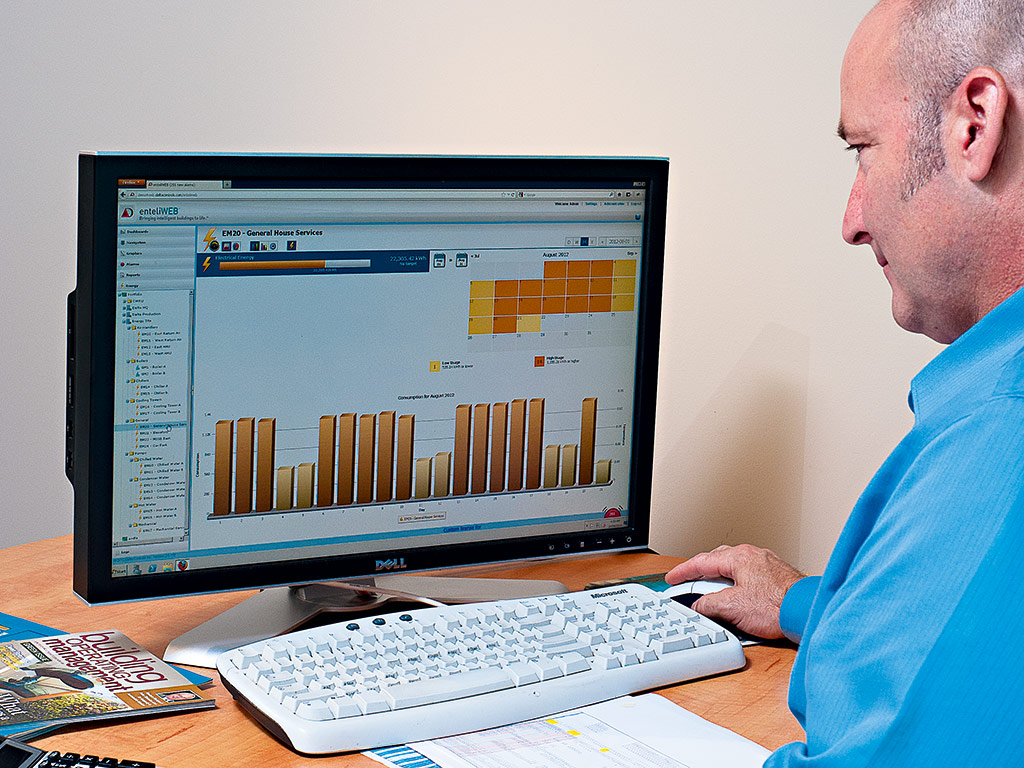Delta Controls looks to simplify costly building operating systems
The effectiveness of building operating systems is being diminished by their complexity. David Stephen from Delta Controls thinks he has the solution

A facilities manager using the Delta Controls enteliWEB building management system
Rental income has been reduced by 2.9 percent and overall building income 3.23 percent since 2011. According to the International 2013 Experience Exchange Report from the Building Owners and Managers Association (BOMA), building owners and managers are looking to offset those costs by maximising their building efficiency.
Joe Markling, BOMA International Chair, and Managing Director of Strategic Accounts with CBRE, says: “Property professionals know that strong asset management is more important than ever, and the continued and significant decreases in utilities and other expenses underscore the fact that well-run buildings can thrive in any market condition.”
The complexity of multiple building operating systems could be diminishing the effectiveness of your building’s facility
staff, and inhibiting potential savings
For most, the operations required to maintain a building’s systems are usually unnoticed or, at best, thought about only when things go wrong. Somewhere in your facility is a department full of people, or maybe just someone, whose sole purpose is to ensure the entire process is invisible.
Behind the scenes, there is a complex network of computer-controlled systems, from lighting to heating and ventilation through to security and access controls. Every year, more and more of a building’s systems are becoming centrally controlled, and the amount of information being generated and data being collected is starting to become overwhelming.
The complexity of multiple building operating systems could be diminishing the effectiveness of your building’s facility staff, and inhibiting potential savings. What should be the peak of efficiency turns into a control room more akin to data displays on the New York Stock Exchange Floor, each displaying a different set of graphics, alarms and alerts for each controlled system.
Your building’s facility manager and maintenance staff have to sift through each different system to identify, prioritise, troubleshoot and resolve any irregularity. What’s more, your management team doesn’t just expect the building to run: you need the savings building automation systems should deliver – and you’d like to see the evidence of that in reporting.
Fulfilling the promise
The scale of complexity is amplified when applied to property management companies measuring KPIs throughout multiple facilities nationwide – or university campuses or hospitals, with not only multiple buildings, but also a variety of specialised environments.
The larger the site, the more challenging the task of simply monitoring each building’s controlled systems becomes. We have, in essence, gone back to the earliest days of patrolling the engineering levels looking at gauges, except that it is now all done through a mouse and keyboard. How can we achieve the promise of simplicity first introduced with the advent of modern building management system controls?
Separate energy measurement and building operating systems now just don’t make sense
David Stephen from Delta Controls thinks he has the answer: “My goal with enteliWEB was to be able to provide a single screen that could, in a glance, let anyone from the facility manager through to the CEO know exactly how their building was performing.”
The goal of Delta Control’s new flagship software platform was ambitious: how do you find that one-size-fits-all format that will work for both a strip-mall and a national real-estate management company? Surprisingly, you don’t.
“What we’ve done is build a framework that allows each user to have their own customised dashboard interface,” says Stephen. “It’s obvious that the CEO, the facility manager and maintenance staff all need radically different pieces of information in completely different formats. enteliWEB gives each user the ability to customise their dashboards quickly and easily by themselves without the need for programmers or specialised skills.”
Taking a proactive approach
For your building, single-seat operational control can mean the difference between your facility management being proactive and reactive. If facility staff can spot the tell-tale signs of an issue early through a simple, flexible interface, then resources can be allocated more effectively.
By using the same systems as the facilities staff to create cost projections and calculate ROI through actual building data, fiscal management of your building can be based on fact. Further than that, building management systems’ dashboards should link seamlessly into the building automation system so your facilities team can make real time changes to schedules and systems set points directly from the software.
“Separate energy measurement and building operating systems now just don’t make sense,” says Brian Goodchild, President of Delta Controls. “Your system needs to be flexible enough to track building performance and adjust the building systems”.
enteliWEB empowers your facilities team to identify issues and act quickly to control operating costs. You can make the building more controllable and report on the energy efficiency improvements you wanted in one intuitive interface. Make sure you are optimising and protecting the value of one of your largest assets: your building.













